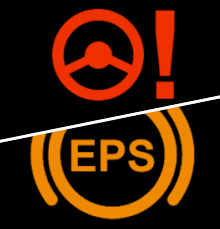In the symphony of dashboard indicators, few can strike as much concern as the power steering warning light. This seemingly small icon can signal significant issues that, if ignored, might lead to costly repairs or even dangerous driving conditions.
| Section | Key Points |
|---|---|
| What is Power Steering? | – Assists in turning car wheels, making maneuvering easier – Two types: Hydraulic (HPS) and Electric (EPS) – HPS uses pump and fluid; EPS uses electric motor |
| Power Steering Warning Light | – Looks like a steering wheel icon, often with “!” or “EPS” – Yellow/Amber: Need attention soon – Red: Serious issue, immediate attention needed |
| Common Causes | – Low or contaminated power steering fluid (HPS) – Faulty pump or broken belt (HPS) – Leaks in the system (HPS) – Failed motor or sensors (EPS) – General electrical problems |
| What to Do When Light’s On | – Don’t panic, assess steering feel – Find safe place to stop if steering is hard – Try restarting car (for EPS) – Check & top up fluid (HPS) – Look for leaks, listen for noises – Call for help if needed |
| Preventive Maintenance | – Regular fluid checks (HPS) – Follow service schedules – Inspect belts and hoses – Address small issues promptly – Use correct fluid type (HPS) – Be gentle when steering |
| Risks of Ignoring | – Complete power steering failure – Steering rack damage (HPS) – Further electrical issues (EPS) – Higher accident risk – Higher repair costs |
| Conclusion | – Light is a critical communication tool – Understanding it saves money & ensures safety – Could indicate broader issues – Always respect warning lights – Safe driving includes vehicle maintenance |
In this comprehensive guide, we’ll delve into the intricacies of your car’s power steering system, decode what that warning light means, and provide you with actionable steps to keep your vehicle safe and operational.
What is Power Steering?
Before we dive into the warning light, it’s crucial to understand what power steering is and why it’s so important. Power steering is a system that assists you in turning your car’s wheels, making it much easier to maneuver your vehicle, especially at lower speeds or when stationary.
In the early days of automobiles, steering was entirely mechanical. The force you applied to the steering wheel was directly transmitted to the wheels through a series of mechanical linkages. This made steering, particularly in larger vehicles or at low speeds, a real workout. The introduction of power steering in the 1950s revolutionized driving, making it accessible and comfortable for a broader range of people.
Today, there are two primary types of power steering systems:
- Hydraulic Power Steering (HPS): This traditional system uses a pump, driven by the engine’s belt, to pressurize hydraulic fluid. This fluid helps to amplify the force you apply to the steering wheel, making it easier to turn.
- Electric Power Steering (EPS): Increasingly common in modern vehicles, EPS uses an electric motor to assist steering. It’s more energy-efficient as it doesn’t rely on engine power and allows for variable assistance based on driving conditions.
Decoding the Power Steering Warning Light

When your power steering warning light illuminates, it’s your car’s way of saying, “Hey, there’s something wrong with the system that helps you steer!” The light typically looks like a steering wheel, often with an exclamation mark or the words “EPS” or “POWER STEERING.”
The color of the light can provide additional information:
- Yellow or Amber: This usually indicates a problem that needs attention soon but isn’t an immediate emergency.
- Red: A red light suggests a serious issue that requires immediate attention. In some cases, it might even be unsafe to continue driving.
Common Causes of Power Steering Issues
Several factors can trigger your power steering warning light:
- Low Power Steering Fluid (HPS systems): Just like engine oil, power steering fluid can get low over time due to small leaks or natural consumption. When the fluid level drops too low, the system can’t generate enough pressure to assist steering properly.
- Contaminated Power Steering Fluid (HPS systems): Over time, the fluid can become dirty or break down, reducing its effectiveness. This is why regular fluid changes are part of many service schedules.
- Faulty Power Steering Pump (HPS systems): The pump is the heart of a hydraulic power steering system. If it’s failing, it won’t be able to pressurize the fluid correctly.
- Broken or Stretched Belt (HPS systems): The power steering pump is typically driven by a belt connected to the engine. If this belt breaks or stretches, the pump won’t function.
- Leaks in the System (HPS systems): Hoses, seals, or the steering rack itself can develop leaks, causing fluid loss and pressure drop.
- Failed Electric Motor or Sensors (EPS systems): In electric systems, issues often stem from the motor itself or the sensors that determine how much assistance to provide.
- Electrical Problems: Both HPS and EPS systems rely on electrical components for control and monitoring. Fuses, wiring issues, or ECU (Engine Control Unit) problems can all trigger the warning light.
What to Do When the Light Comes On
- Don’t Panic: While a power steering issue is serious, panicking can lead to poor decisions. Stay calm.
- Assess the Steering Feel: Is the steering much heavier than usual? Does it feel “normal”? This can help you gauge the severity of the issue.
- Find a Safe Place: If steering feels significantly harder or the light is red, find a safe place to pull over as soon as possible. Continuing to drive could be dangerous.
- Turn Off and Restart: Sometimes, particularly with EPS systems, a simple reboot can clear temporary glitches. Turn off the engine, wait a minute, and restart. If the light stays off and steering feels normal, you’re probably okay to proceed, but still get it checked soon.
- Check Fluid Level (HPS systems): If it’s safe to do so, check your power steering fluid level. Look for the reservoir under the hood (consult your manual for location) and see if it’s between the MIN and MAX lines. If it’s low, top it off with the correct type of fluid.
- Look for Leaks: With the car safely parked, look underneath for any signs of leaking fluid. It’s often reddish or brown in color.
- Listen for Noises: A whining or groaning noise when turning the wheel often indicates a problem with the power steering pump or low fluid.
- Call for Help: If you can’t safely continue driving, it’s best to call for a tow. AAA, local mechanics, or your car’s roadside assistance are good options.
- Get Professional Help: Even if you can drive, get to a mechanic soon. Power steering issues tend to worsen over time.
Preventive Maintenance
The best way to handle power steering issues is to prevent them:
- Regular Fluid Checks (HPS systems): Make it a habit to check your power steering fluid level monthly, just like you would with oil or coolant.
- Follow Service Schedules: Many manufacturers recommend power steering fluid changes at specific intervals. Follow these guidelines.
- Inspect Belts and Hoses: During oil changes or other service, have your belts and hoses inspected for wear, cracks, or leaks.
- Address Small Issues Promptly: If you notice the steering feeling slightly off or hear occasional noises, get it checked. Small issues often become big ones.
- Use the Right Fluid (HPS systems): Power steering systems are sensitive to fluid type. Always use the fluid specified in your owner’s manual.
- Be Gentle: Turning the wheel to its full lock (all the way to one side) puts extra stress on the system, especially when not moving. Try to avoid this when possible.
The Risks of Ignoring the Warning Light
Ignoring your power steering warning light can lead to several serious consequences:
- Complete Power Steering Failure: If you run out of fluid or the pump fails completely, you’ll suddenly find yourself without any power assistance. This can be extremely dangerous, especially if you’re not prepared for the increased effort needed.
- Steering Rack Damage: In HPS systems, low fluid can cause the steering rack to wear prematurely. This is a much more expensive repair than just topping up fluid.
- Further Electrical Issues: In EPS systems, continuing to drive with a known issue can lead to more extensive electrical problems, potentially affecting other car systems.
- Accident Risk: Without proper power steering, you might not be able to make quick maneuvers to avoid hazards, significantly increasing your risk of an accident.
- Higher Repair Costs: As with most car issues, catching and fixing them early is almost always cheaper than waiting until they become severe.
Conclusion
Your car’s power steering warning light is more than just another dashboard icon—it’s a critical communication tool between you and your vehicle. Understanding what it means, how to respond, and the importance of preventive maintenance can save you from costly repairs, stressful breakdowns, and potentially dangerous driving situations.
Also Read:
- The 6.6L Duramax Engine: A Deep Dive into Common Problems
- Tundra Engine Problems: A Comprehensive Guide for Toyota Owners
- Ford 4.2L V6 Engine Problems: A Comprehensive Guide
- Ford 3.5L V6 EcoBoost Engine Problems: A Comprehensive Analysis
- Ford 5.4 Engine Problems: A Deep Dive into America’s Workhorse
Remember, modern cars are complex machines with numerous interconnected systems. What seems like “just a power steering issue” could be a symptom of broader electrical or mechanical problems. Always treat warning lights with the respect they deserve, and when in doubt, consult a professional mechanic.
Safe driving isn’t just about following traffic rules; it’s also about ensuring your vehicle is in top condition. By staying attentive to signals like the power steering warning light, you’re not just protecting your car—you’re safeguarding yourself, your passengers, and everyone else on the road.


[…] Understanding Your Car’s Power Steering Warning Light: A Comprehensive Guide […]